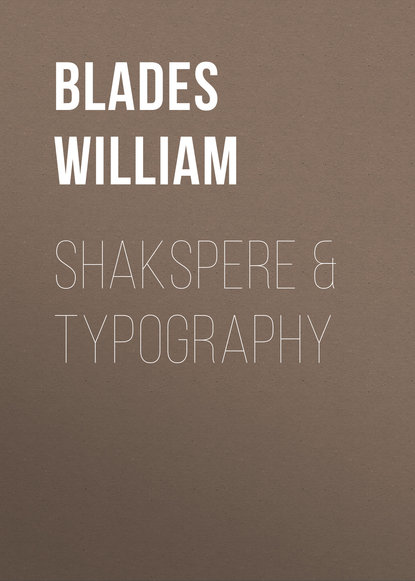По всем вопросам обращайтесь на: info@litportal.ru
(©) 2003-2024.
✖
Shakspere & Typography
Настройки чтения
Размер шрифта
Высота строк
Поля
Print on my lips another kiss,
The picture of my glowing passion.
Nay, this wont do – nor this, nor this;
But now – Ay, that’s a proof impression.
Many of Vautrollier’s publications went through several editions. In the ‘Merry Wives’, II, 1, Mistress Page says:
These are of the second edition,
and well can we imagine Shakspere handing volumes to a buyer with the same remark, or asking some patron with whom he was a favourite:
Com’st thou with deep premeditated lines,
With written pamphlet studiously devised?
1 Henry VI, iii, 1.
as the author entered with a roll of ‘copy’ in his hand.
In the deep mine from which the foregoing quotations have been dug, many others would doubtless reward a more careful search. As it is, numerous allusions, which, though plain to a printer, would seem too forced to the general public, have been passed over. Enough, however, has probably been brought forward to justify the belief pourtrayed in the title-page, viz.: That Shakspere must have passed some of his early years in a Printing-office.
notes
1
The exact date was probably as difficult to arrive at then as now. The arrival of William Caxton in England may, with a certainty of being near the truth, be placed in 1475-6, the date 1474 given by most writers being a misconception of the language used by Caxton in the Preface to the Chess-book. The Art on its first introduction was looked upon suspiciously by the people, few of whom could read, its chief patrons being a few of the more educated among the nobles and the rich burghers of London. Another mistake is to suppose that Caxton printed in Westminster Abbey. His printing-office was a tenement to the south-east of the Abbey Church; its sign was the ‘Red-pale’, and Caxton rented it of the Abbot. There is evidence to show that Caxton and the Abbot were on distant terms of amity – none to show that the Ecclesiastic encouraged or patronised the Printer, notwithstanding Dean Stanley’s assertions in a sermon lately preached by him in Westminster Abbey. The only occasion upon which Caxton mentions the Abbot is to this effect – that the Abbot, not being able himself to read a passage in old MS., sent it to Caxton, with a request that he would translate it. (See The Life and Typography of William Caxton, by William Blades. 2 vols., 4to. London, 1861-63.)
2
Fat Pages. ‘Fat’ as a conventional word is not confined to Printers. ‘A fat living’ is a phrase not unknown among churchmen, and is used in the same sense by the compositor, who charges the master-printer for the fat pages, in which no work appears, at the same rate as if they were full.
3
This word ‘counterfeit’ in the sense of ‘reprint’ or ‘duplicate’, is certainly not used now-a-days by English printers; yet I find this in Marahren’s Parallel List of technical Typographical terms: – ‘Counterfeit, to, or to Reprint, v., Nachdrucken. – Ré-imprimer.’ With Bibliographers the word is still retained; e. g. ‘Lyons counterfeits of the Aldine editions.’
4
And Folly (doctor-like) controlling skill. It is worth noting, that in none of the various volumes written to show Shakspere’s knowledge of medicine and medical men, has the truth of this passage been brought forward in evidence.





